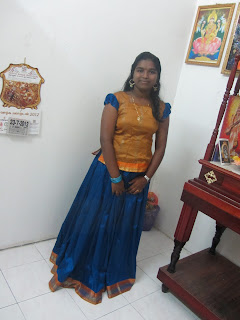Baju Baju Baju
6:22 PMClothing in Malayisa, like most everything else here depends a lot on people's ethnicity.
Day to day wear is similar to the US.. Teen fashion in particular is very similar, and shops like Forever 21, Cotton On, and Abercrombie are popular here as well. A typical outfit would be jeans and a t-shirt or nicer blouse.\ The Chinese and Indians tend to show more skin; the Malays generally cover up a bit more, wearing mostly long sleeves and long pants. Some Malays wear the tudung (headscarf) but this is a personal choice and there are no laws that require Muslims, or non-Muslims to wear it. Some people, especially in the older generation, still wear traditional clothing all the time, see below for what this looks like.
Around the house is a different story. Most people go home, change out of their school uniform, and put on comfy lounge-wear type clothes. At first, I'd always put on jeans after school, but they aren't comfortable at all. So now I keep it casual in comfy clothes.
Actually, now I usually just end up wearing my pajamas around the house during the daytime...Comfy, indeed.
Traditional wear is where things get really interesting. This varies drastically from race to race, so I'll break it up that way. (Please enjoy my modeling as well...)
 |
| my friend Rachael in baju kebaya |
 |
| Me and my LP's sister in baju kurung |
 |
 |
| Men in baju melayu. Found this pic on google and I'm still cracking up |
 |
 |
| Pattu Pavadai |
 |
| bling-bling |
 |
| blang-blang |
 |
| fancy punjabi |
 |
| bangles! |
 |
| Cheongsam |
.jpg) |
| Menswear |









6 comments
You have me dying to wear all these clothes. Are you still taking sari orders? ;)
ReplyDeletei came, i fed, i conquered
ReplyDeleteHannah sayang,Chinese women traditional dress is called cheongsam, not cheongasm :) hey, u r too cute in tudung ok..love it :)
ReplyDeleteHi Hanna!!it's nice to read your story..it is so awesome!!actually...i want to correct something about what you've said about tudung..actually..it is a must for muslim women to cover their hair in front of ajnabi..maybe you dont know what ajnabi is but you can ask your host family about it..hehehe..so, that's why many malay women wear tudung to cover their head and hair. for those who didn't wear tudung, it means that they are not religious enough
ReplyDeletegood produk
ReplyDeleteDISTRIBUTOR TAS UNTUK SEPATU DAN SANDAL
realy nice...
ReplyDelete